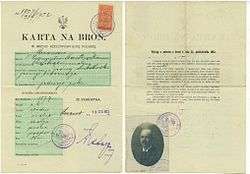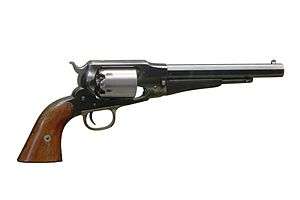Gun laws in Poland
Polish law allows firearm ownership on shall-issue basis for hunting, sport shooting and collection purposes and may-issue basis for self-defense purposes. With approximately 2.5 civilian firearms per 100 people, Poland is the 166th most armed country in the world. Only 0.6% of citizens have valid firearm permits.

History

In 1919 Polish government issued the first law dealing with firearm ownership. It stated that people needed government's permit to purchase and own firearms. Law didn't specify conditions needed to obtain them so authorities had full discretion.
During Nazi occupation (1939-1945) civilians were banned from owning firearms and those breaking the law were subject to capital punishment. In 1939 Polish historian and writer Rafał Marceli Blüth along with 15 people was executed for illegal possession of a gas mask.
Recent history of Polish gun laws:
- 1999: First law dealing with firearms passed after fall of communism allows possession on may-issue basis.
- 2001: Some air guns were allowed without permit.[1]
- 2003: Replicas of pre-1850 firearms were allowed without permit.
- 2011: Licensing procedures changed to shall-issue.[2] Replicas of pre-1885 firearms were allowed without permit.
- 2014: Holders of sport shooting permits were allowed to carry their weapons concealed.
- 2020: Hunting with suppressors was allowed.
Law
Gun ownership in Poland is regulated by the Weapons and Munitions Act of 21 May 1999, as further amended,[3] which requires a permit to own and possess firearms. The law requires that a prospective permit holder shows an important reason for owning firearms for a specific purpose, the purposes themselves and associated reasons are enumerated in the act.
Individuals' Permits
The current text of the law (as of August 1st 2019) lists the allowable purposes (also known as permit types), important reasons entitling to possession and allowed gun categories. The law states that permits are shall issue, however the condition (important reason) for self-defense and protection of persons and property permits is vague enough to make it may issue in practice.
| Purpose | Important reason | Allowed guns |
|---|---|---|
| Self-defence | Constant, real and higher than average threat to life, health or property. | Centerfire pistols and revolvers 6 to 12 mm in caliber, gas guns, alarm guns.[lower-alpha 1] |
| Protection of persons and property[lower-alpha 2] | Constant, real and higher than average threat to life, health or property. | Same as above, plus flare guns, submachine guns 6 to 12 mm in caliber, 12-gauge non-auto shotguns, full-auto rifles 5.45 to 7.62 mm in caliber. |
| Hunting | Authorization for hunting, as determined by hunting laws. | Hunting shotguns and rifles, as prescribed in hunting laws. |
| Shooting sports | Membership in a sports shooting association, sports qualifications proved by association exam, valid competition license. | Rimfire guns with rifled bore up to 6 mm in caliber, centerfire guns with rifled bore up to 12 mm in caliber, 12-gauge smooth bore shotguns, black powder guns.[lower-alpha 3] |
| Training | Being a certified firearms instructor running a registered business in firearms training. | All of the above. |
| Historical re-enactments | Membership in a historical society and active participation in re-enactment events. | Guns modified to fire blanks only, including full-auto ones. |
| Collecting | Membership in a gun collectors' association. | All of the above.[lower-alpha 4] |
| Memorial | Acquisition of a gun by inheritance, donation or distinction.[lower-alpha 5] | All of the above.[lower-alpha 4] |
| Other (at the discretion of the police) | Police discretion. | As prescribed in the permit. |
- i.e. devices emitting only sound and gases, no projectile. Note that alarm guns less than 6 mm in caliber are unrestricted.
- No permit of this type has been issued since at least 2015, according to police statistics.
- Pre-1885 black powder guns are unrestricted; this provision allows possession of post-1885 black powder guns.
- However in 2018 Supreme Administrative Court ruled that full auto firearms are dangerous weapons and cannot be issued for collectors despite the law allowing it explicitly.
- Until the permit is issued, the acquired gun has to be held in police deposit
Additionally, individuals may apply for a gun possession permit which allows handling guns by employees or associates of a business owning them.
Institutional Permits
Institutions, businesses and other organizations may apply for permits if they operate in specific areas of business and fulfill specific business licensing regulations. These include:
- businesses which have organized their own internal security services (such as major factories),
- businesses with a valid concession in private law enforcement services,
- shooting ranges,
- schools; sports, hunting and paramilitary organizations (solely for training purposes),
- film-making and other artistic enterprises,
- entities which employees' duties involve high exposure to the risk of being attacked,
- entities which need guns for signalling for help, search and rescue activities, or signalling the start of sport competitions.
The first two types of business units and schools providing instruction in private law enforcement may acquire full-auto weapons. The guns owned by a business may be handled only by its employees or associates having a gun possession permit.
Common Conditions
To obtain a firearms permit, the applicant have to:
- be at least 21 years old (or 18 in case of sports or hunting licence on special recommendation by sports or hunting association)
- not be addicted to alcohol or other psychoactive substances,
- be a permanent resident of Poland,
- have no criminal record,
- pass medical and psychological evaluation by appropriately certified practitioners,
- in the opinion of the police, does not present a threat to him/herself or public security and order (involves interview of the applicant and optionally applicant's family and/or neighbors by a police officer),
- provide appropriate documentation (such as hunting, sports, historical or collectors' association membership, sports or hunting license, company registration etc.),
- pass an exam appropriate for the purpose of possession of a firearm:
- held by the Polish Sport Shooting Federation for a sports permit,
- held by the Polish Hunting Association for a hunting permit,
- held by the police for other types of permits.
Permit holder have to possess a certified gun safe (the police may pay a visit to check it up), and request a certification for buying guns of type and quantity according to the permit terms. This certification has to be handed to the person or business transferring gun(s) to the new owner. Acquired guns have to be registered with the police and recorded in the permit document within 5 days.
Permits are issued for an indefinite period, although self-defense, protection of persons and property and hunting ones require passing medical and psychological evaluation every five years. Additionally, sports permit requires the holder to maintain a valid shooting sports competition license, by taking part in two to four shooting competitions per year for each category of firearm owned: handgun, rifle and shotgun, in order to upkeep the firearms permit.
Each individual permit specifies the types (handguns, rifles, shotguns) and quantity of weapons the holder can own. The types allowed depend on gun permit type (see above), sports competition license and actual request by the applicant. Allowed quantities are determined at the discretion of the police, and vary greatly depending on permit type and documented needs, but it's an established practice to receive typically 5 slots for sports or hunting and 10 slots for collecting initially. The permit holder may apply for an increased limit after running out of slots. One may apply for multiple types of permits to increase the total number of slots, such as sports and hunting or sports and collecting permits.
All legal owners are allowed to use their guns at registered shooting ranges. Discharging a firearm for training or leisure out of a registered shooting range (even on a large private property) is prohibited.
Fully automatic firearms

Currently only way to obtain working fully automatic firearm in Poland is via training permit. They also can be purchased for protection of persons and property (hard to get) and historical re-enactment purposes (only blank-firing ones).
A few automatic firearms permits have been issued for collection purposes after 2011 however in 2018 Supreme Administrative Court ruled than they are dangerous weapons and cannot be issued for collectors despite law allowing it de iure.[5]
Sound suppressors
Police is prohibited from issuing permits for firearms featuring a sound suppressor or capable of accepting a sound suppressor except for hunting permits. However, in practice only firearms with permanently attached suppressors are deemed to fall under this rule as almost any firearm is capable of accepting a sound suppressor. That's why only a solution specifically intended to mount a suppressor would fulfill the second condition.[6] Suppressors themselves are unregulated; obtaining, and owning is legal. Using a suppressor is not directly prohibited[7] apart from hunting, but different legal opinions exist and the case has not been tested in court.
In 2020 new amendment to Arms and Ammunition Act allowed police to issue permits for firearms with a sound suppressors for hunting permits. Hunters are allowed to use them only for sanitary shooting of animals[8]
Ammunition and Magazines
Armor-piercing, incendiary, explosive, tracer, sub-caliber and other special ammunition is banned. Only valid firearms permit holders are allowed to buy or possess live ammunition, and only of the types exactly matching the guns they legally own; even a single non-matching round in possession may trigger a criminal prosecution or revocation of the permit. The quantity of matching ammunition in possession is not limited. Hunters, collectors and sports shooters are allowed to manufacture (reload) ammunition, but strictly for their own use.
There's no limit on magazine capacity, except when hunting: maximum 6 rounds total, including magazine and all chambers, however for semi-auto guns a hunter can load only 2 rounds into the magazine (not including chambered rounds).[9]
Carrying firearms
Only firearms owned for self-defense, protection of persons and property and sport shooting purposes can be carried loaded in public places. Firearms have to be carried concealed in a holster close to the body so other people cannot see them. Police can limit or forbid carrying while issuing the permit at its discretion.
Guns cannot be carried during public events and assemblies, in ports and on ships (with exceptions) and in courts and state's attorney offices. Person carrying must be sober. Guns carried in public transport must be unloaded (no round in the chamber, empty magazines) except on self-defense and protections of persons and property permits – in this case the magazine can be loaded and connected, but no round in the chamber.
Hunting guns can be carried loaded only on hunting grounds.[10]
There are no regulations regarding movement of unloaded guns, as long as they are under direct supervision of a licensed person. However the Ministry of Internal Affairs may forbid or limit carrying loaded and/or unloaded guns in certain places for a limited time. It has become a common practice to issue such limits during major events such as international conferences, visits of prominent political figures, mass public gatherings, significant sports championships or even on such occasions as National Independence Day.[11]
Unrestricted guns

Replicas of black powder firearms designed before 1885 require no permit to own, and are therefore quite popular in the shooting community. Separate bill of law[12] allows businesses to sell black powder only to licensed customers. This legal loophole is often circumvented by obtaining a European Gun Card for your black powder firearm, asking a colleague (there's no restriction on private sale or just giving out of black powder) or by buying powder in neighboring countries, mostly the Czech Republic.
Black powder firearms can be carried loaded in public places (but not in public transport) without permit.[13]
Other types of unrestricted weapons include:
- Airguns up to 17 Joules of muzzle energy. More powerful airguns need to be registered with the police, but no permit is required;
- Alarm guns with caliber less than 6 mm;
- Deactivated weapons (certificate of deactivation is required);
- Pepper sprays;
- Electroshock weapons with current not exceeding 10 mA.
Other restricted weapons
Other types of weapons that require permit according to the law include:
- Specific cold weapons, including hidden blades, brass knuckles, nunchakus, wooden or metallic batons;
- Crossbows;
- Electroshock weapons with current exceeding 10 mA.
Firearm ownership
There are currently 551,410 registered firearms owned by 224,651 people.[14] According to Small Arms Survey there are total 968,000 licit and illicit firearms or around 2.5 per 100 people.
| Purpose | Licensed people | Registered firearms |
|---|---|---|
| Self-defense | 33528 | 37860 |
| Protection of persons and property | 9 | 10 |
| Hunting | 129347 | 339320 |
| Sport shooting | 35045 | 88777 |
| Historical re-enactments | 68 | 281 |
| Collection | 24031 | 78006 |
| Memorial | 1727 | 2508 |
| Training | 723 | 4474 |
| Other | 173 | 174 |
Gun crime

Gun crimes are very rare in Poland. According to police statistics number of homicides and homicide-attempts using firearm decreased from 111 in 2002 to 25 in 2018, but number of suicides using firearm increased from 55 in 79 in the same period, corresponding to increase in firearm ownership among ordinary people.
Mass shootings are almost non-existent. Examples include school shooting in May 2019 when a student wounded two people using an unlicensed black powder firearm and some fireworks[15][16].
See also
References
- Olsztyn. Pojawiła się groźna broń, którą można sprzedawać bez koncesji
- "Mniej uznaniowości w pozwoleniach na broń". Tvn24 (in Polish). Retrieved 11 January 2019.
- Weapons and Munitions Act, full text, isap.sejm.gov.pl.
- BROŃ SAMOCZYNNA - DOSTĘPNA NA POZWOLENIE SZKOLENIOWE LUB KONCESJĘ
- Naczelny Sąd Administracyjny: broń samoczynna zdolna do rażenia celów na odległość, nie może być posiadana do celów kolekcjonerskich
- Letter from General Police Headquarters stating that even a threaded barrel does not mean the firearm is capable of accepting a sound suppressor, trybun.org.pl
- Czy wolno w Polsce strzelać z tłumikiem? (Blog post with an overview of suppressor legality), gunblog.eu
- "Dwie ustawy z podpisem Prezydenta". January 29, 2020.
- Executive Order of the Minister of Environment amending the Executive Order regarding specific requirements for hunting and marking game of 15 November 2011, isap.sejm.gov.pl.
- NOSZENIE BRONI – cz. II. Warunki noszenia broni.
- Executive Order of the Ministry of Internal Affairs and Administration of 6 November 2019 regarding temporary ban on carrying and moving firearms
- Conducting Business in Producing and Trading of Explosives, Firearms, Munitions and Military and Police Goods and Technology Act, full text, isap.sejm.gov.pl.
- "Policja potwierdza: noszenie broni czarnoprochowej legalne". Wykop.pl (in Polish). Archived from the original on 31 March 2016. Retrieved 30 May 2018.
- Liczba osób, którym wydano pozwolenie na broń (2019) – Polish Police
- Strzelanina w szkole w Brześciu Kujawskim. Wśród rannych 11-letnia uczennica
- Strzelanina w szkole w Brześciu Kujawskim. Kula przeszła centymetr od rdzenia 11-letniej Oliwii